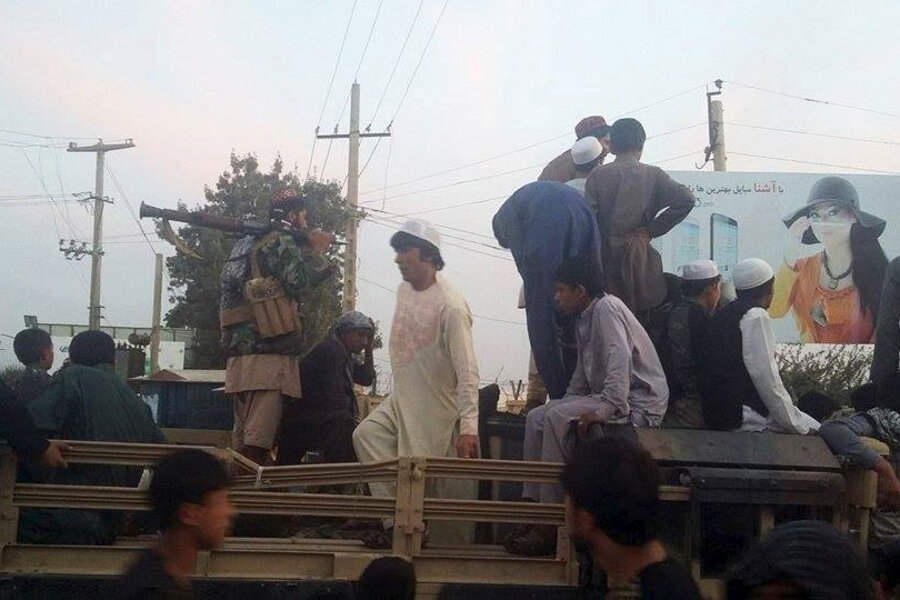Taliban topples Kunduz: what that means for Afghanistan's security
Loading...
| Washington
The Taliban's successful campaign to seize control of a major city in the far north of Afghanistan is a strong symbol of the shortcomings of the country's security forces. But it is also a warning sign that, in the long run, could prove an important teachable moment for Afghan forces and the American troops who train them, say top former military officers who served in the country.
United States-trained Afghan troops are now engaged in a closely-watched urban battle to try to retake Kunduz, the nation’s sixth-largest city and capital of Kunduz Province.
After trying to topple the city on a number of occasions, the Taliban succeeded Monday. Hundreds of prisoners escaped from the local prison, and hundreds of thousands of civilians locked themselves in their homes in anticipation of tough street-to-street fighting.
Monday marked the first time since the US military entered Afghanistan after 9/11 that a provincial capital has fallen to the Taliban. That “has huge symbolic importance, and that’s why there’s a huge amount of attention on it,” says retired Lt. Gen. David Barno, who commanded US forces in Afghanistan from 2003 to 2005.
“The actual significance of it is another question,” he adds.
For starters, it does suggest that the ability of Afghan National Security Forces to defend key regions of the country is in question, Mr. Barno notes. “It’s not a good sign from my point of view in terms of the strength of the ANSF.”
Taliban strength in the north has grown as the US and Germany have ramped down forces during the past two years, says Barno, now a distinguished practitioner in residence at American University’s School of International Service in Washington.
“Now [the Taliban] only have to deal with Afghan forces,” he notes.
But that fact could prove instructive for US forces, he and other analysts add.
“It reveals that the Taliban is stronger than we thought in some ways, but it does so at a time when we still have the flexibility to adapt our presence in the region,” says Paul Scharre, a former special operations reconnaissance team leader in the 3rd Ranger Battalion, with multiple tours to Iraq and Afghanistan.
The question is whether that’s advisable, he adds. The current commander of US forces in Afghanistan, Gen. John Campbell, recently requested that US troops levels in the country remain at 10,000 beyond the end of 2016, The Wall Street Journal reported last week.
“But ultimately, the Afghans have to be able to fight and defend their country on their own,” notes Mr. Scharre, now a senior fellow at the Center for a New American Security.
The fall of Kunduz could help Afghan and US forces address critical weaknesses.
“One thing that needs to happen is to take a hard look at your intelligence infrastructure across the country,” Barno says. “There should have been the ability to collect the intelligence to indicate that this attack is in the offing. It shouldn’t be a surprise.”
The fall of Kunduz may also be a good time to look at whether the Afghan Army needs to shuffle assets around, he adds. In the immediate aftermath of the Taliban takeover, the government in Kabul rushed well-regarded Afghan commandos to the region, for example.
That’s to be expected, but “militarily, you want to make sure you know what the situation is before you throw a bunch of forces into it,” Barno notes. This includes assessing the level of training and capability of Afghan forces posted up there. “Are there enough forces, and were those forces trained and led properly?” he adds.
Finally, it’s worth keeping in mind that up until this point, there have been essentially two models for dealing with non-governed spaces in the post-9/11 world, Scharre argues.
“First, you can send in 100,000 troops in and occupy and try to rebuild it – that’s a model that has costs millions in dollars and thousands in lives,” he says.
The other model is drones and air attacks, “which don’t seem to ever fully solve the problem,” Scharre adds. “In Syria, in Anbar, Iraq we’re grappling with this.”
Kunduz could underline the need to consider new models, he says – “one where US soldiers aren’t fighting, but some level of support is reasonable.”








